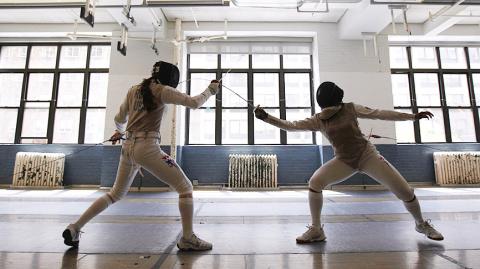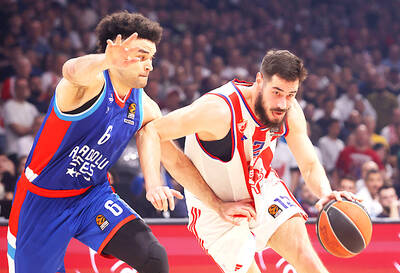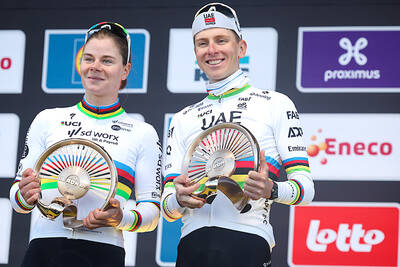Almost 30 years ago, the tight-knit sport of fencing suffered a tragic accident with the horrific death of world and Olympic champion Vladimir Smirnov.
While the Soviet fencer’s death at the Rome World Championships in 1982 shocked the sport to its core, the fatal accident proved to be a turning point in making fencing safer.
Smirnov was fencing West Germany’s Matthias Behr in Rome. Both stood over 1.82m tall and were described by coaches and teammates as massively strong and fast, their attacks akin to an oncoming locomotive.

Photo: Reuters
They attacked each other simultaneously in an attempt to establish an advantage, or what is known in fencing as the “right of way,” Smirnov’s former coach Alexander Perekalsky, 87, said in a recent telephone interview from Moscow.
“Smirnov tried to block Behr’s blade with an upward parry, that Behr avoided. Both collided and Behr’s blade broke on Smirnov’s chest and by inertia he continued forward,” Perekalsky said.
“The broken blade hits a brand new mask and goes through, hitting him above the left eye and into his brain,” he added.
Smirnov died about 10 days later after being taken off life support, his death mourned by the entire fencing world.
Behr left fencing in the aftermath of the accident, but returned to win the foil silver at the 1984 Los Angeles Olympics, and headed Germany’s national fencing training center in Tauberbischofsheim.
Ioan Pop, the international technical director for fencing’s governing body (FIE), said the current standard of safety in the sport owed much to the accident 30 years ago.
“It was absolutely the accident and the death of Smirnov in 1982, in Rome,” said Romanian Pop, who won two Olympic team bronze medals in saber.
Pop is responsible for making sure fencing at the London Olympics is safe as well as enjoyable to watch.
While safety is paramount, the real challenge is to make sure spectators can see the action, no easy task given the tip of a fencing blade is believed to be the second-fastest moving object at the Olympics after the marksman’s bullet.
Massive floor lights wrapping around the fencing area will flash when the wireless electronic scoring equipment is set off by a touch, either on or off the valid target.
Slow-motion instant replay for judges, and new for Olympic spectators this year, makes decisions more transparent. That is a big improvement from the past, when national interests very often hid behind the subjective reasoning of the referee.
And in foil, the lightest of the three weapons that include epee and saber, the bib — or area below the chin — is now a valid target, increasing the pace of a bout.
In an era of ballistic-grade fabric for uniforms, stronger steel, more rigid masks that stand up to 12kg punch tests and the banning of the running attack in saber, safety has improved and injuries severe enough to knock a competitor out of competition remain low.
Despite the dramatic images of blistering clashes with swooping metal weapons and ear-piercing screams of aggression, the sport is significantly safer than American football, soccer or basketball, according to a five-year study by the United States Fencing Association published in 2008.
When compared with a database of collegiate sports injuries, the association’s study, led by chief medical officer Peter Harmer, found injury rates 50 times greater in soccer than in fencing.
Between 1995 and 2005, fatal injuries because of participation in US high school and collegiate football reached 143,63 deaths for basketball and 20 for soccer. In the past 100 years there have been no reported deaths in US fencing.
Worldwide since Smirnov, Harmer said there are just seven confirmed fatalities.

Japanese badminton star Chiharu Shida on Tuesday told Chinese fans to “stop stalking” her, adding that she was “very scared” by the unwanted attention. Shida, who won women’s doubles bronze at the Paris Olympics last year, has a strong following in China partly because of her engagement with the local culture. The 27-year-old, currently competing at the Badminton Asia Championships in Ningbo, China, has been dubbed the “Badminton Goddess” by fans and media. She hit out at some supporters on Tuesday, accusing them in an Instagram post of taking their fandom too far. “Every time we compete in China we always experience the harm

Two people died on Thursday after fans and police clashed outside the Estadio Monumental in Santiago ahead of a game in South America’s Copa Libertadores, Chilean authorities said. The fatalities happened shortly before the match between Chile’s Colo-Colo and Brazilian club Fortaleza, when police blocked about 100 fans when they attempted to enter the stadium. There were conflicting accounts of how the fatalities occurred, with local media reporting that one of the dead was a 13-year-old boy. The other victim was an 18-year-old woman, according to a relative at the hospital where she was treated. The fans died after being caught underneath a

A potential European league could be a gold mine for the NBA as the top-flight North American league looks to muscle its way into a deep pool of talent across the Atlantic Ocean. The NBA is exploring the launch of a European league with world basketball governing body FIBA as a partner, NBA commissioner Adam Silver said last week, with an eye toward a 16-team format made up of 12 permanent clubs and four qualifiers. The continent’s longstanding Euroleague quickly signaled its readiness to enter into talks with the NBA, even as it has balked at the idea of another league in

Tadej Pogacar on Sunday won an epic see-saw showdown at the Tour of Flanders, soloing home from 15km, with Mads Pedersen edging Mathieu van der Poel to second at the line a minute later with Wout van Aert fourth. The duel between the Slovenian and defending champion Van der Poel played out across the 17 hills in bright sunshine before Pogacar broke away. World champion Pogacar, who won the Giro d’Italia and the Tour de France last year, collected his eighth one-day Monument, moving ahead of one-day specialist Van der Poel on seven. “The goal was to win, but at